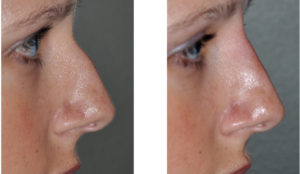The use of numerous types of injectable fillers for filling in wrinkles and folds and making lips bigger has had a huge impact on traditional non-surgical cosmetic procedures. Such filling agents can be extended to other facial applications as well, including helping to make some changes in the shape of the nose as well. Known as injectable rhinoplasty, some call it the non-surgical nosejob or the 5 minute rhinoplasty, putting temporary injectable fillers into the nose in select areas can help reshape it. It produces instant results without the swelling, bruising or costs of surgery….and it takes but a few minutes.
For those patients who desire changes in the shape of their nose but don’t want any of the issues associated with traditional rhinoplasty surgery, the use of injectable fillers is an alternative and the only option. Done in the office under a combination of topical and local anesthetic, various spots on the nose are injected to change its shape. In particular, bumps on the nose can be camouflaged, the nose can be made to look straighter, a plunging tip can be lifted, and the base of the nose can be brought out. After injecting the material, the nose can be reshaped with one’s fingers to get the shape desired. While the result is not permanent, it will last up to 6 months.
This injectable concept is really just an extension of having used such fillers to build-up chins, cheeks, and jaw angles which has been done for some time. The difference in the nose is that only the upper third of it is bone. The middle and tip portions of the nose are pieces of cartilage that have a complex anatomic arrangement. One has to have a good appreciation of the underlying anatomy to properly place the material. In my opinion, injectable rhinoplasty should only be done by someone who knows how and regularly performs traditional rhinoplasty surgery.

For some patients who may be considering rhinoplasty surgery but have trouble envisioning what the outcome may be, the injectable approach can offer a temporary solution to determine if one can ‘live’ with the result. I consider this a step between computer-imaging and actual surgery. Most patients do not need it, but in rare instances it may be helpful for the very uncertain.
While many different injectable fillers exist, all of them can be used in the nose. Although be aware that none of them are FDA-approved for this use. That being said, I consider them all to be safe and the differences between collagen, hyaluronic-acid based, or particulated fillers is how long they last not which one is better.
Dr. Barry Eppley
Indianapolis, Indiana


